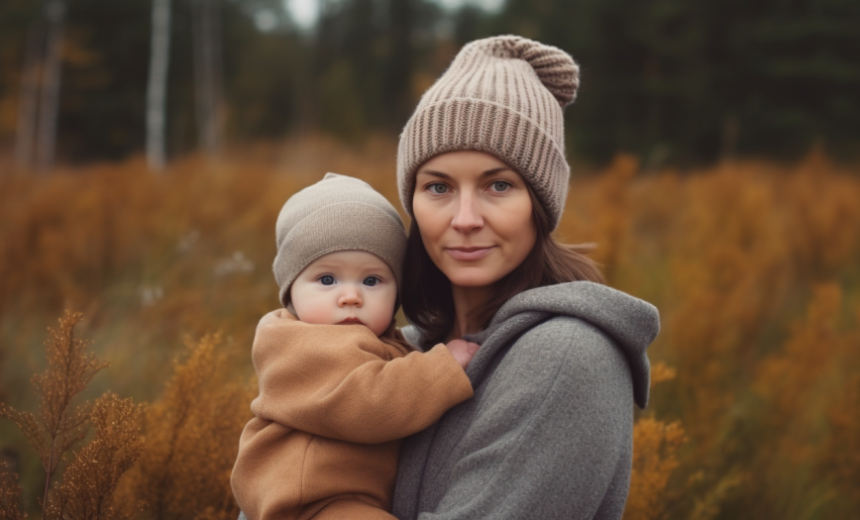As the seasons shift and temperatures fluctuate, parents face the essential task of dressing their infants appropriately to ensure comfort and protection from the elements. Particularly in 60-degree weather, a temperature often characterized by mildness, the challenge lies in striking a balance between warmth and breathability. Understanding the physiological needs of babies, who are less adept at regulating their body temperature compared to adults, is crucial for maintaining their comfort and well-being.
This article delves into the principles of dressing infants in moderate climates, offering practical guidance on fabric selection, layering techniques, and essential accessories. By examining these strategies, caregivers can better navigate the complexities of infant attire, fostering a nurturing environment that promotes healthy development and comfort during transitional weather.
Choosing the Right Base Layers for Optimal Warmth and Comfort

Selecting the appropriate base layers is crucial for ensuring that your baby remains warm and comfortable during cooler temperatures, particularly when the mercury dips to around 60 degrees. Base layers should serve as a second skin, effectively managing moisture and providing insulation without adding bulk. Materials such as merino wool and synthetic fibers like polyester are often preferred due to their ability to wick away sweat, thereby keeping your child dry and cozy. Here are key features to consider when choosing the right base layers:
-
- Moisture-wicking properties: Helps in regulating body temperature.
-
- Breathability: Allows air circulation, preventing overheating.
-
- Fit: Should be snug yet comfortable, allowing for ease of movement.
-
- Layering ability: Should easily fit under other garments.
When evaluating options, it is also essential to consider the climate and the level of activity your baby will partake in. For milder days, lighter base layers may suffice, while cooler conditions might necessitate thicker materials. A helpful reference for selecting base layers can be encapsulated in the following table:
| Material Type | Benefits | Considerations |
|---|---|---|
| Merino Wool | Excellent insulation and moisture control | Can be more expensive, may require special care |
| Polyester | Durable, quick-drying, and affordable | Less breathable than natural fibers |
| Silk | Soft, light, and comfortable | Less thermal insulation; may not withstand wear |
By implementing these considerations, you can ensure that your baby’s base layers not only contribute to their comfort but also support their overall warmth during outdoor activities. Ultimately, an informed choice in base layers will lead to a more enjoyable experience for both you and your little one.
Selecting Appropriate Outerwear to Shield Against Changing Conditions
When dressing your baby for 60-degree weather, selecting the right outerwear is crucial to ensure their comfort and protection against the elements. At this temperature, a lightweight jacket or fleece is often sufficient, but it’s essential to keep in mind the potential for fluctuating conditions throughout the day. **Layering** is an effective strategy that allows you to easily adjust your baby’s clothing as the temperature changes. Opt for breathable materials that wick moisture away from the skin, which can help regulate body temperature and prevent overheating.
Consider the following options when choosing outerwear:
-
- Lightweight Jackets: Ideal for mild weather, offering coverage without bulk.
-
- Fleece Layers: Provide warmth while remaining lightweight; they are also easy to pack away.
-
- Water-Resistant Options: Essential for unpredictable rain or wind, keeping the baby dry and warm.
Additionally, it is beneficial to check the forecast for wind chill or any impending weather changes. Incorporating a hat and mittens can also protect your baby’s extremities from the chilly air. Use the table below to help decide the appropriate outerwear based on expected conditions:
| Condition | Recommended Outerwear |
|---|---|
| Mild and Sunny | Lightweight jacket |
| Cloudy with a Breeze | Fleece layer with a windbreaker |
| Occasional Drizzle | Water-resistant jacket |
Accessorizing for Additional Protection Against Chill and Wind
When venturing out with your baby in cooler 60-degree weather, selecting the right accessories can effectively shield them from the elements. Consider layering with the following items to enhance warmth and protection:
-
- Warm Hats: A snug-fitting beanie or knit hat can retain heat, covering the delicate head and ears.
-
- Scarves: A soft, lightweight scarf can provide additional neck warmth, while also acting as a barrier against biting winds.
-
- Gloves or Mittens: Keeping tiny fingers warm is essential. Opt for mittens, as they offer more warmth by allowing fingers to share body heat.
-
- Booties: Insulated booties will safeguard the baby’s feet; look for options with non-slip soles for added safety.
It’s also important to consider materials that offer wind resistance and breathability to prevent overheating while keeping your baby warm. Accessories made from fleece or thermal fabrics are excellent choices. When layering, ensure that the outermost layer is slightly larger to accommodate for movement, while still maintaining a snug fit. Here is a simple overview of effective material choices:
| Accessory | Material | Benefits |
|---|---|---|
| Hat | Fleece | Retains heat & moisture-wicking |
| Scarf | Merino Wool | Soft & insulating |
| Mittens | Thinsulate | Warmth without bulk |
| Booties | Water-resistant fabric | Prevents wetness & cold |
Monitoring Your Babys Temperature to Ensure Safe Comfort Levels
Keeping track of your baby’s temperature is essential in ensuring their comfort and safety, particularly in cooler weather. Since infants are more susceptible to temperature fluctuations, it is vital to monitor their body heat regularly. A baby’s normal temperature typically ranges between **97°F to 100.3°F** (36.1°C to 37.9°C). When dressing your baby for 60-degree weather, consider using a thermometer to check for any signs of overheating or chilliness. Some indicators to watch for include:
-
- Skin temperature: Feel their forehead, neck, and back for any unusual warmth or coldness.
-
- Behavior: Observe if your baby is unusually fussy or lethargic, which could indicate discomfort.
-
- Clothing adjustment: If your baby feels clammy, it may be time to reduce layers.
In addition to temperature checks, understanding how to layer clothing effectively can prevent your baby from becoming either too warm or too cold. Start with a lightweight base layer made from breathable materials like cotton, followed by a warmer middle layer such as fleece or wool. add a wind-resistant outer layer to shield against drafts. A simple guide for layering in 60-degree weather can be summarized in the following table:
| Layer Type | Recommended Material | Purpose |
|---|---|---|
| Base Layer | Cotton | Moisture-wicking and breathable |
| Middle Layer | Fleece/Wool | Insulation to retain heat |
| Outer Layer | Wind-resistant fabric | Protection from wind and elements |
Q&A
Q&A: How to Dress Baby in 60 Degree Weather: Keeping Them Comfortable
Q1: What is the ideal temperature range for dressing a baby comfortably?
A1: The ideal temperature range for dressing a baby comfortably varies but generally falls between 68°F to 72°F (20°C to 22°C). In cooler conditions, such as 60°F (15.5°C), it is crucial to adapt the baby’s clothing to ensure they remain warm without overheating, as infants are particularly sensitive to temperature fluctuations.
Q2: How should a parent assess their baby’s comfort in 60-degree weather?
A2: Parents can assess their baby’s comfort by observing their behavior and physical cues. Signs that a baby is too cold include fussiness, shivering, or cool extremities, while overheating may manifest as excessive sweating, flushed skin, or irritability. It is advisable to check the baby’s neck or back for warmth; these areas should feel warm but not sweaty.
Q3: What types of clothing are recommended for a baby in 60-degree weather?
A3: For 60-degree weather, layering is key. A recommended outfit might include a lightweight long-sleeve onesie as a base layer, followed by a soft sweater or fleece top for added warmth. It is also advisable to use pants or leggings to cover the legs, and a light jacket or hooded cardigan can provide extra insulation during outdoor excursions. Hats and mittens may be necessary if it is particularly breezy.
Q4: Should babies wear socks or booties in this weather?
A4: Yes, it is recommended that babies wear socks or booties in 60-degree weather. Infants often have less body fat and can lose heat quickly through their extremities. Therefore, keeping their feet warm with suitable footwear helps maintain overall body temperature.
Q5: How does the type of fabric impact how a baby feels in cooler temperatures?
A5: The type of fabric significantly affects a baby’s comfort in cooler temperatures. Natural fibers, such as cotton and wool, provide breathability and insulation, making them excellent choices for base layers. Avoid synthetic fabrics that may trap moisture against the skin, as this can lead to discomfort, especially if the baby is active or in a humid environment.
Q6: Are there any accessories that can aid in keeping a baby comfortable in 60-degree weather?
A6: Accessories such as lightweight hats, which can help retain body heat, and sun hats for outdoor protection are beneficial. Additionally, lightweight blankets can be used in strollers or car seats to provide an extra layer of warmth without bulk, ensuring that the baby is comfortably dressed for their environment.
Q7: How can parents ensure their baby remains comfortable while transitioning between indoor and outdoor environments?
A7: To ensure comfort during transitions between indoor and outdoor environments, parents should dress their baby in layers that can be easily added or removed. Keeping a light blanket on hand for outdoor excursions allows for flexibility in adjusting warmth. Additionally, having a portable stroller cover can help shield the baby from wind while maintaining warmth without the need for heavy outerwear.
Q8: Are there any common mistakes parents should avoid when dressing their baby for 60-degree weather?
A8: Common mistakes include overdressing or underdressing the baby. Parents might mistakenly assume their baby needs the same amount of clothing as an adult, leading to overheating. Conversely, underestimating the chill, especially with wind or shade, can result in the baby being too cold. It is essential to consider individual factors such as the baby’s activity level, the wind chill, and any additional layers they may be subjected to when choosing an appropriate outfit.
Conclusion:
Dressing a baby in 60-degree weather requires a combination of appropriate layering, careful observation, and attention to fabric choices. By understanding the basic principles of temperature regulation and responding to their baby’s needs, parents can ensure their little ones remain comfortable and happy in varying weather conditions.
In Retrospect
dressing an infant in 60-degree weather necessitates a thoughtful approach that prioritizes comfort, safety, and adaptability. The guidelines outlined in this article underscore the importance of layering textiles that are both breathable and warm, ensuring that the infant’s body temperature remains regulated throughout the day. Parents and caregivers should remain vigilant, regularly checking for signs of discomfort or overheating, and adjusting clothing as needed. By understanding the principles of thermal comfort and using appropriate materials, caregivers can provide a nurturing environment that promotes well-being. As we continue to explore the intersection of infant care and climate awareness, it becomes increasingly vital to equip ourselves with knowledge that empowers us to make informed decisions for our children’s health and comfort.

